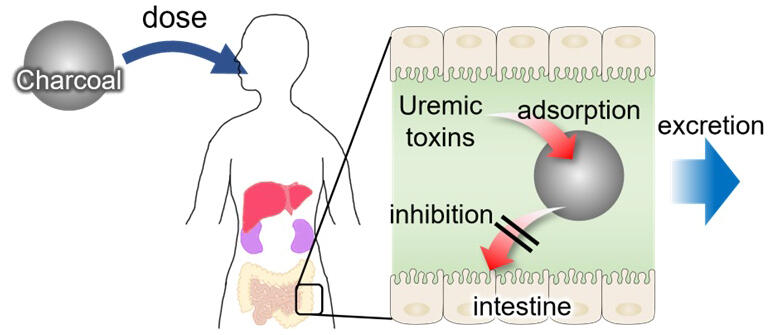To slow the progression of chronic renal failure, activated carbon-based medical adsorbents are used to remove uremic toxin precursors; however, they impose a burden on patients because high doses are required owing to poor selectivity. A research group led by Professor Tsuyohiko Fujigaya, Associate Professor Koichiro Kato, Assistant Professor Naoki Tanaka, third-year doctoral student A.B.M. Nazmul Islam, and second-year Master's student (at the time of the research) Mai Akamine of the Graduate School of Engineering of Kyushu University discovered that mesoporous carbon with pores of about 3 nanometers has three times higher adsorption selectivity for indole than commercially available adsorbents in the presence of various amino acids. The study was published in Carbon Reports.

Provided by Kyushu University
Chronic renal failure is considered a national affliction, affecting one in eight adults in Japan. Dialysis is the only treatment option available if the renal disease progresses to the terminal stage. Dialysis causes physical and mental suffering to patients due to the long hours of treatment and imposes a heavy medical and economic burden. Therefore, oral adsorbents, in addition to a low-protein diet and blood pressure control, are used as a treatment method to decelerate the progression of chronic renal failure.
Kremezin (manufactured by Kureha Corporation), an oral adsorbent based on spherical porous activated carbon, was introduced as a pharmaceutical product in 1991, and various activated carbon preparations for medical use with many improvements have been developed since then. These oral adsorbents target uremic toxin precursors such as indole in the gut, minimizing their absorption from the intestine. However, due to low adsorption selectivity, they also adsorb nutrients such as vitamins and digestive enzymes.
Thus, patients had to take a large dose of 6 grams per day to adsorb a sufficient amount of uremic toxin precursors. However, consuming large amounts of oral adsorbents daily was a significant burden, as patients with chronic renal failure must adhere to strict fluid intake restrictions. In addition, these adsorbents were often accompanied by side effects such as constipation and loss of appetite.
The research group attributed the low selectivity of conventional adsorbents to their highly variable pore sizes and focused on mesoporous carbon, which has controllable pore sizes in the nanometer range. They prepared mesoporous carbon with pores approximately 3 nanometers in size. They found it exhibited over three times higher selectivity for indole adsorption in the presence of amino acids than the commercially available activated carbon Kremezin. Computational simulations and comparative experiments revealed that tryptophan and phenylalanine, which are amino acids slightly larger than indole, are adsorbed only in small amounts because it is difficult for them to enter the pores, indicating that the size-controlled pores acted like a sieve for indole adsorption.
Fujigaya said, "Because this discovery is still the result of experiments in flasks, we are now planning to conduct experiments in animals. We will continue our research with the aim of delivering an actually effective adsorbent to patients with chronic renal failure."
Journal Information
Publication: Carbon Reports
Title: Selective adsorption of indole on mesoporous carbon in an aqueous system
DOI: 10.7209/carbon.030304
This article has been translated by JST with permission from The Science News Ltd. (https://sci-news.co.jp/). Unauthorized reproduction of the article and photographs is prohibited.




